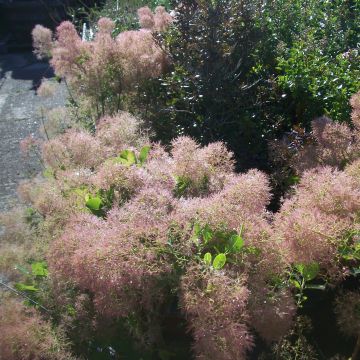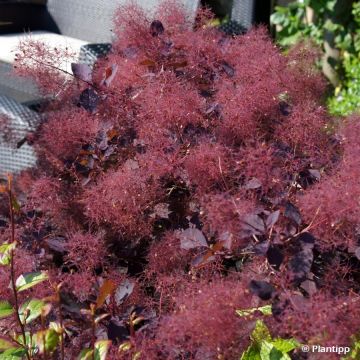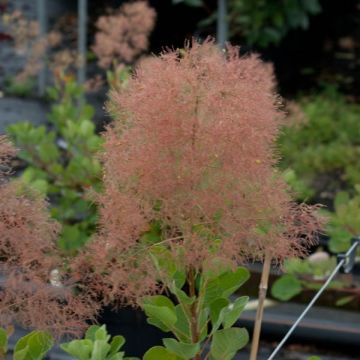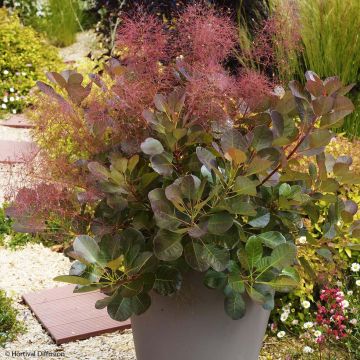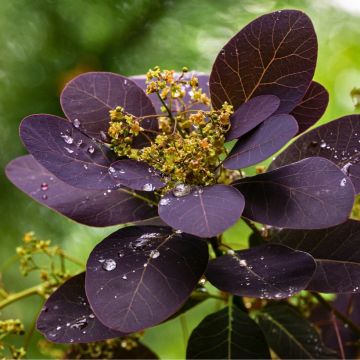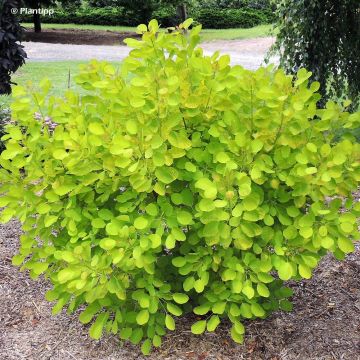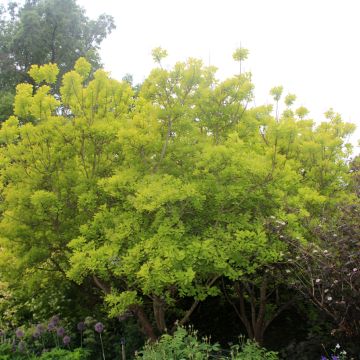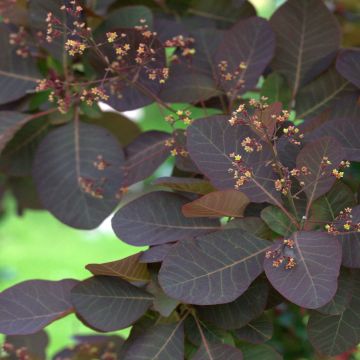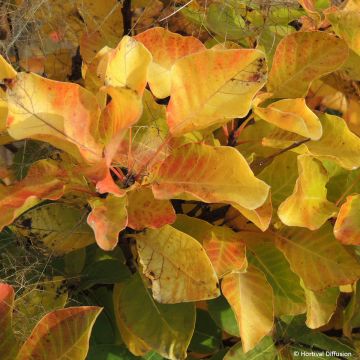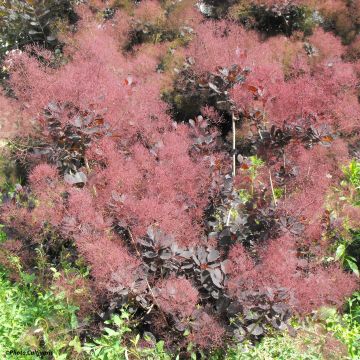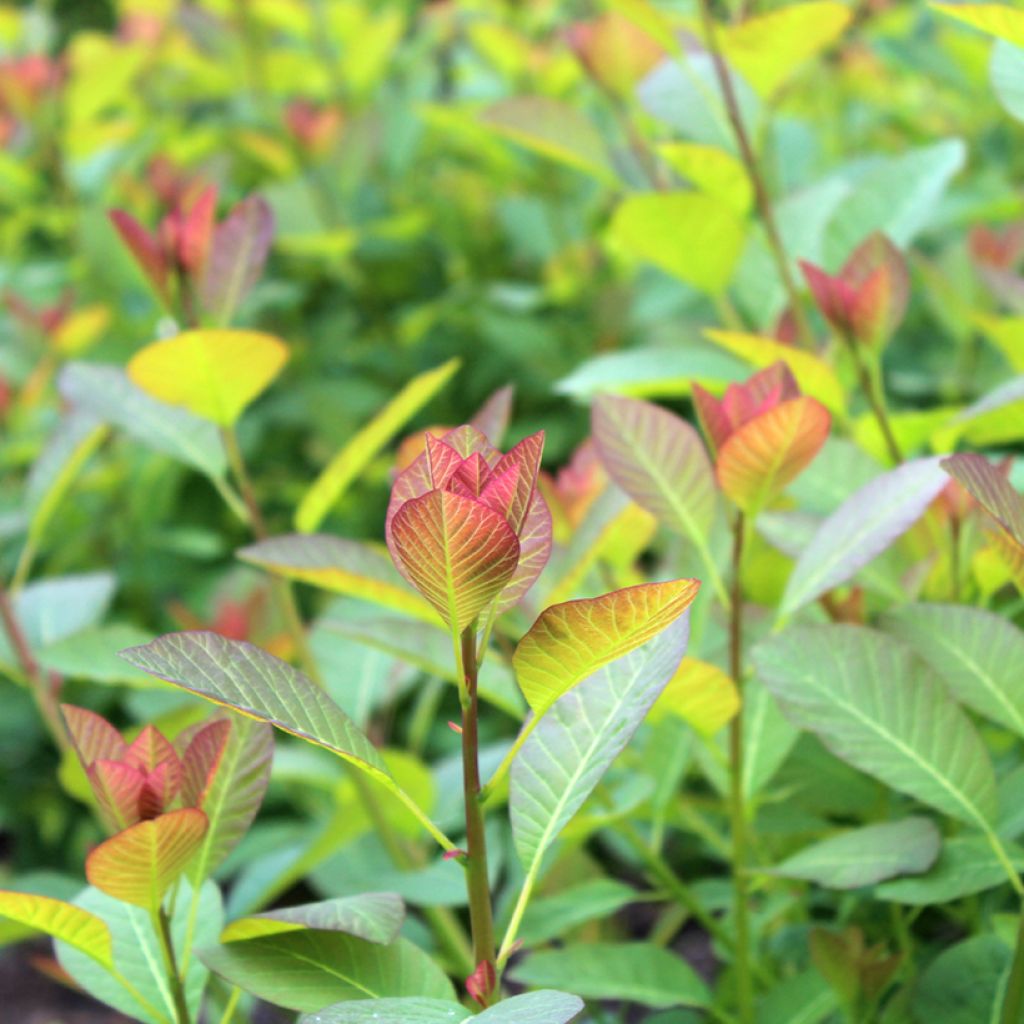

Cotinus coggygria Flame - Smoke Bush
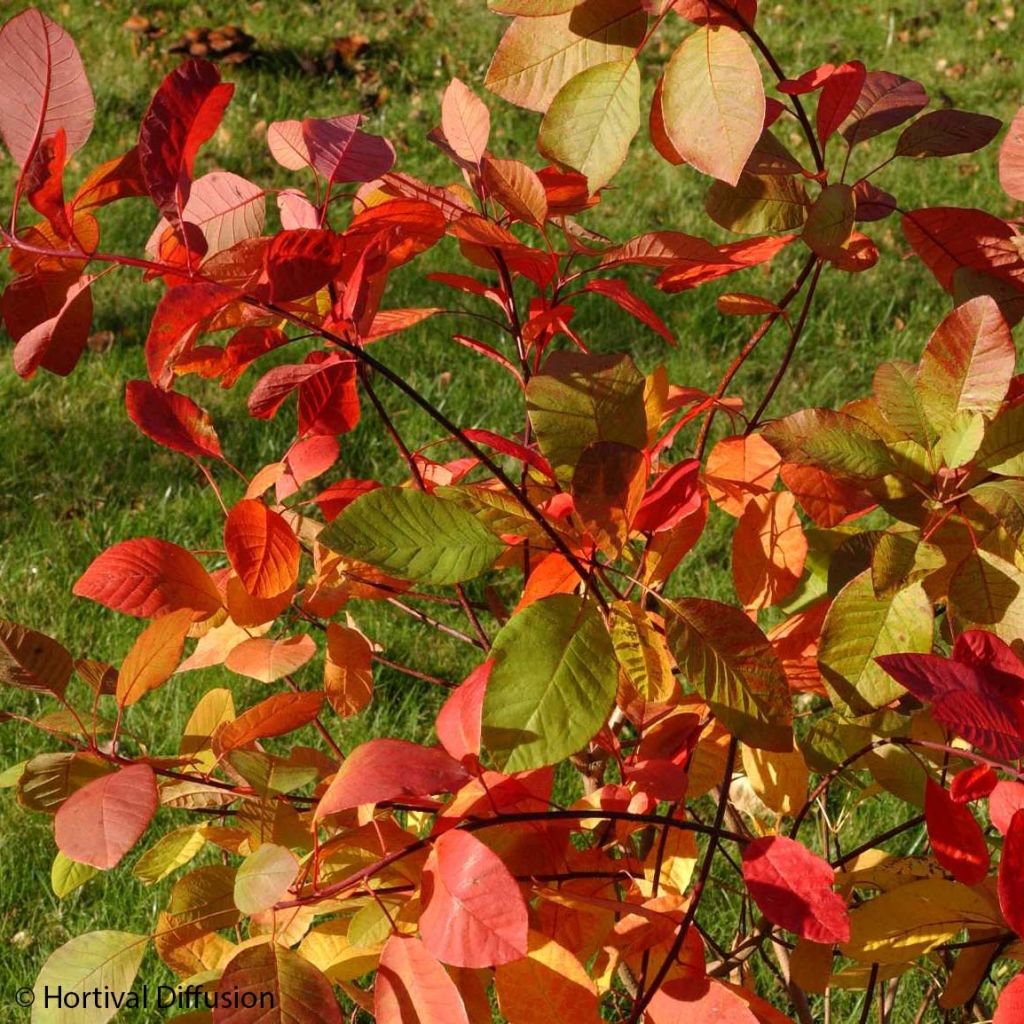

Cotinus coggygria Flame - Smoke Bush
Cotinus coggygria Flame - Smoke Bush
Cotinus coggygria Flame
Smoke Bush, European Smoke Tree, Venetian Sumach, Dyer's Sumach
Why not try an alternative variety in stock?
View all →This plant carries a 24 months recovery warranty
More information
We guarantee the quality of our plants for a full growing cycle, and will replace at our expense any plant that fails to recover under normal climatic and planting conditions.
From €5.90 for pickup delivery and €6.90 for home delivery
Express home delivery from €8.90.
Does this plant fit my garden?
Set up your Plantfit profile →
Description
Cotinus coggygria 'Flame' is a variety of bush known for its distinctive round and regular habit, and its foliage that changes from brown in spring to green and then to yellow-orange to fiery red in autumn! It forms a large bush with large smooth egg-shaped leaves, whose colours are enhanced by bright red petioles, veins, and young stems. From June to July, it produces airy panicles of pinkish-purple flowers that turn dark purple-brown and remain decorative until October. This variety shares the same hardiness and robustness as the species, only disliking heavy and overly rich soils. It particularly enjoys warm and sunny exposures, and well-drained, poor, rather dry, even rocky and limestone soils. This variety maintains a bushy and compact appearance without requiring regular pruning. It is a dazzling subject that should be planted in the back of borders or as a stand-alone specimen, near the terrace to admire it up close.
Cotinus coggygria, also known as smoke bush, is a bush from the family Anacardiaceae, native to southern Europe and Asia. In nature, it grows on rocky slopes, on poor soils and in dry climates. The variety 'Flame' is particularly compact and has a regular habit. It reaches a height of about 5m (16 ft 5 in) and a width of 2.5m (8 ft 2 in) at maturity. In June, Cotinus coggygria 'Flame' produces panicles of small pinkish-purple flowers, whose pedicels elongate to form a long feathery fruit cluster covered in hairs: the inflorescence then takes on a smoky brown-purple hue, which earned this species its name of smoke tree. Its round, deciduous leaves, 10 to 15 cm (3.9 to 5.9 in) long, appear as early as April and change colour throughout the season.
Truly easy to grow and extremely undemanding, Cotinus 'Flame' can find a place in any garden, even in a large container on the terrace. In this case, a large and stable container that won't be toppled by the wind should be chosen. Once well established in the garden, it tolerates drought well but doesn't tolerate excessive moisture in winter, especially in heavy soils. Like deciduous euonymus, it is very useful for brightening up informal hedges or evergreen bush borders that are not too tall, such as boxwoods, escallonias, and compact cherry laurels. Its fabulous autumn colours pair perfectly with late-flowering shrubs in shades of pink and large autumn asters with mauve flowers (Aster laevis, turbinellus...). Otherwise, use it to bring colour and dynamism to informal hedges and as a background for your borders with grey or golden foliage species such as grasses and lavenders. In bouquets, combine its purple flower plumes with white, pink, red, mauve, or violet roses.
Report an error about the product description
Cotinus coggygria Flame - Smoke Bush in pictures
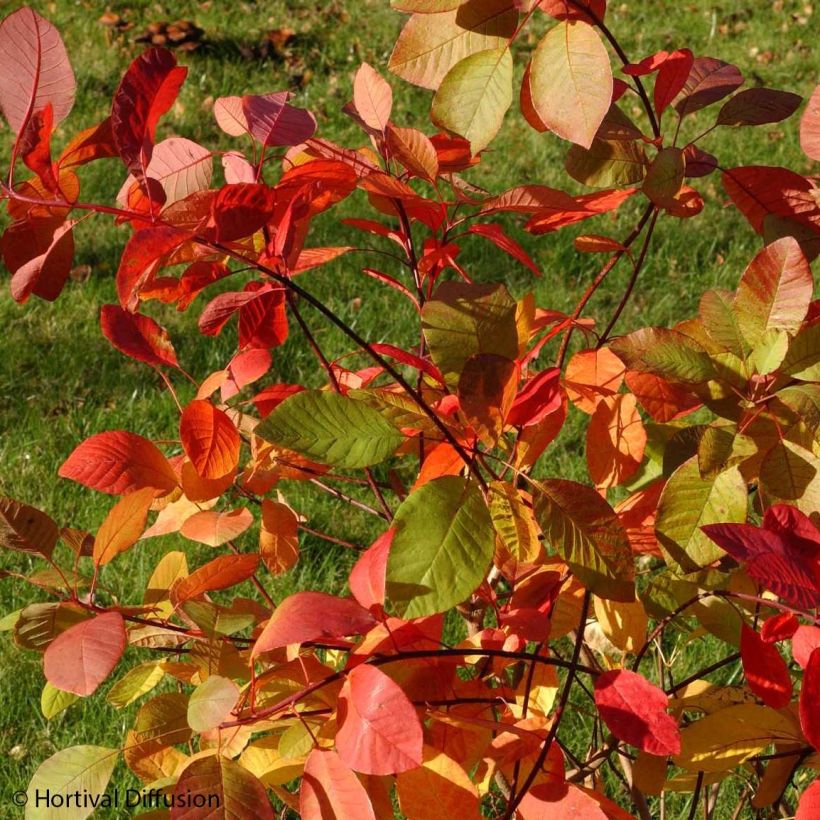

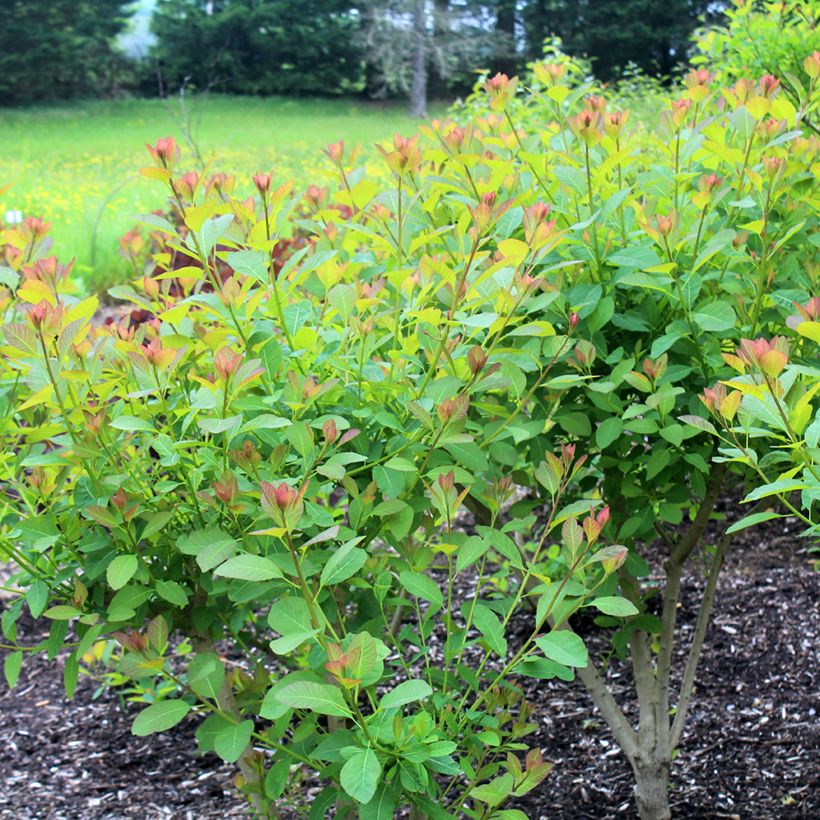

Plant habit
Flowering
Foliage
Botanical data
Cotinus
coggygria
Flame
Anacardiaceae
Smoke Bush, European Smoke Tree, Venetian Sumach, Dyer's Sumach
Cultivar or hybrid
Other Cotinus - Smokebush
Planting and care
Cotinus coggygria 'Flame' is best grown in a well-drained, poor and light soil. It accepts limestone everywhere and clay soils in dry climates. It tolerates poorly acidic soils, both compact and waterlogged in winter. This bush is very well adapted to drought and summer heat. It prefers the sun but can tolerate partial shade, where its foliage may be slightly less flamboyant.
Planting period
Intended location
Care
This item has not been reviewed yet - be the first to leave a review about it.
Haven't found what you were looking for?
Hardiness is the lowest winter temperature a plant can endure without suffering serious damage or even dying. However, hardiness is affected by location (a sheltered area, such as a patio), protection (winter cover) and soil type (hardiness is improved by well-drained soil).

Photo Sharing Terms & Conditions
In order to encourage gardeners to interact and share their experiences, Promesse de fleurs offers various media enabling content to be uploaded onto its Site - in particular via the ‘Photo sharing’ module.
The User agrees to refrain from:
- Posting any content that is illegal, prejudicial, insulting, racist, inciteful to hatred, revisionist, contrary to public decency, that infringes on privacy or on the privacy rights of third parties, in particular the publicity rights of persons and goods, intellectual property rights, or the right to privacy.
- Submitting content on behalf of a third party;
- Impersonate the identity of a third party and/or publish any personal information about a third party;
In general, the User undertakes to refrain from any unethical behaviour.
All Content (in particular text, comments, files, images, photos, videos, creative works, etc.), which may be subject to property or intellectual property rights, image or other private rights, shall remain the property of the User, subject to the limited rights granted by the terms of the licence granted by Promesse de fleurs as stated below. Users are at liberty to publish or not to publish such Content on the Site, notably via the ‘Photo Sharing’ facility, and accept that this Content shall be made public and freely accessible, notably on the Internet.
Users further acknowledge, undertake to have ,and guarantee that they hold all necessary rights and permissions to publish such material on the Site, in particular with regard to the legislation in force pertaining to any privacy, property, intellectual property, image, or contractual rights, or rights of any other nature. By publishing such Content on the Site, Users acknowledge accepting full liability as publishers of the Content within the meaning of the law, and grant Promesse de fleurs, free of charge, an inclusive, worldwide licence for the said Content for the entire duration of its publication, including all reproduction, representation, up/downloading, displaying, performing, transmission, and storage rights.
Users also grant permission for their name to be linked to the Content and accept that this link may not always be made available.
By engaging in posting material, Users consent to their Content becoming automatically accessible on the Internet, in particular on other sites and/or blogs and/or web pages of the Promesse de fleurs site, including in particular social pages and the Promesse de fleurs catalogue.
Users may secure the removal of entrusted content free of charge by issuing a simple request via our contact form.
The flowering period indicated on our website applies to countries and regions located in USDA zone 8 (France, the United Kingdom, Ireland, the Netherlands, etc.)
It will vary according to where you live:
- In zones 9 to 10 (Italy, Spain, Greece, etc.), flowering will occur about 2 to 4 weeks earlier.
- In zones 6 to 7 (Germany, Poland, Slovenia, and lower mountainous regions), flowering will be delayed by 2 to 3 weeks.
- In zone 5 (Central Europe, Scandinavia), blooming will be delayed by 3 to 5 weeks.
In temperate climates, pruning of spring-flowering shrubs (forsythia, spireas, etc.) should be done just after flowering.
Pruning of summer-flowering shrubs (Indian Lilac, Perovskia, etc.) can be done in winter or spring.
In cold regions as well as with frost-sensitive plants, avoid pruning too early when severe frosts may still occur.
The planting period indicated on our website applies to countries and regions located in USDA zone 8 (France, United Kingdom, Ireland, Netherlands).
It will vary according to where you live:
- In Mediterranean zones (Marseille, Madrid, Milan, etc.), autumn and winter are the best planting periods.
- In continental zones (Strasbourg, Munich, Vienna, etc.), delay planting by 2 to 3 weeks in spring and bring it forward by 2 to 4 weeks in autumn.
- In mountainous regions (the Alps, Pyrenees, Carpathians, etc.), it is best to plant in late spring (May-June) or late summer (August-September).
The harvesting period indicated on our website applies to countries and regions in USDA zone 8 (France, England, Ireland, the Netherlands).
In colder areas (Scandinavia, Poland, Austria...) fruit and vegetable harvests are likely to be delayed by 3-4 weeks.
In warmer areas (Italy, Spain, Greece, etc.), harvesting will probably take place earlier, depending on weather conditions.
The sowing periods indicated on our website apply to countries and regions within USDA Zone 8 (France, UK, Ireland, Netherlands).
In colder areas (Scandinavia, Poland, Austria...), delay any outdoor sowing by 3-4 weeks, or sow under glass.
In warmer climes (Italy, Spain, Greece, etc.), bring outdoor sowing forward by a few weeks.

































